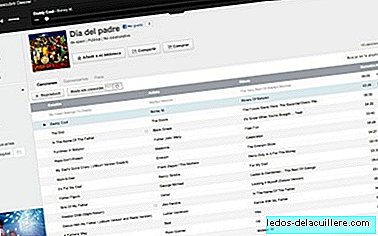
From the age of six months, babies need to start taking foods other than milk, as this is no longer enough to meet all their nutritional needs; then begins the supplementary feeding.
He Baby-Led-Weaning (BLW) It is an increasingly common complementary feeding technique in our country. The exact translation is "weaning guided by the baby“, But we could talk about complementary feeding directed by the baby.
It is about placing different healthy foods within reach of the baby and letting him decide how much, what and how to eat. Many equate BLW to feed without purees, but I don't totally agree. We can also offer purees and let the baby take it alone (something quite complicated in the first months).
Although the BLW is increasingly known, the truth is that sometimes parents who decide on this type of food do not know very well where to start. Then we leave you 11 basic keys to get started in the method.
1. Find out first

As babies do not come with instruction book under the arm, about complementary feeding we must also learn.
Most pediatricians and nurses spend some time reporting this when the time is approaching, but unfortunately not all of them are up to date, much less are they in favor of Baby-Led-Weaning.
Recently the AEP (Spanish Association of Pediatrics) has included it in its Recommendations on Supplementary Feeding, so this would be a good starting point, together with the book of “The child already eats alone”, by Gill Rapley (the creator of the method BLW)
 THE CHILD ALREADY EAT ALONE: Get your baby to enjoy good food (MOTHER AND BABY) On Amazon for € 26.60
THE CHILD ALREADY EAT ALONE: Get your baby to enjoy good food (MOTHER AND BABY) On Amazon for € 26.60"I get a ball", by Julio Basulto or "My child does not eat me", by pediatrician Carlos González, among others, without being exclusively about BLW, it is worthwhile to deepen infant feeding. There are also numerous websites, blogs, groups of Facebook where to share information and answer questions about this method.
2. Make sure your baby is ready

It is essential that your baby be prepared to start the Baby Led Weaning. We will know that the time has come if:
- Is older than six months: Both the WHO and the AEP (Spanish Academy of Pediatrics) and the APP (American Academy of Pediatrics) recommend maintaining exclusive breastfeeding up to six months (and in the case of taking artificial formula or mixed breastfeeding, it is not necessary to introduce other foods before). The body is prepared to receive food other than milk from 4 months (26 weeks) but milk provides all the nutrients we need until 6 months. From that moment, it begins to stay “short” in some aspects and we must take other foods for it
- Is able to sit alone (for example in a high chair, or in an adult's lap)
- You have lost the extrusion reflex. This reflex act allows infants to "protect" themselves against solid foods, other than milk, that are not yet prepared to assimilate. They push with the tongue the spoon or the food that we try to introduce them differently to the breast of their mother or the nipple. This reflex disappears between 4 and 6 months.
- Show interest in food: It's about 6 months when many babies start to be interested in what we eat. However, some do not want more than their mother's breast until 7 or 8 months. Patience… . No hurry…
- He is able to hold food and take it to his mouth
 In Babies and more Baby-led Weaning and choking hazard: children who eat chunks are no longer in danger
In Babies and more Baby-led Weaning and choking hazard: children who eat chunks are no longer in danger3. Follow basic safety rules
The BLW does not seem to be associated with more choking than crushed feeding, as long as the parents have previously informed and follow basic safety standards:
- When eating, the baby should be upright, either sitting on a high chair or on the father's or mother's lap.
- When you eat you should always be supervised.
- Foods with a high risk of choking should not be offered.
- We must not put anything in the child's mouth, it is the child who takes the food and takes it to the mouth
It is not essential to take a first aid course, although I do consider it advisable (in all cases, not only for those who will perform Baby-Led-Weaning). It will give you a lot of peace of mind as parents to know some basic guidelines of action in case of choking.
4. Avoid certain foods because of the risk of choking

Certain foods are associated with an increased risk of choking. Thus, it is advisable to avoid the apple and the raw carrot, the whole grapes (it is advisable to cut them lengthwise into 3 or 4 pieces), the sausages cut into slices (we must divide them first lengthwise), the whole nuts and the popcorn corn. Other small round foods, such as peas, cherry tomatoes, corn, cherries or olives, should also be delayed a few months.
5. Consider your psychomotor development

At the beginning we must offer food in large, strip or cane-shaped pieces, that allow them to hold it with their fists and eat what stands out. Later, they will learn to make the clamp and will be able to pick up smaller and smaller pieces. Later they will learn to eat using cutlery.
 In Babies and more Baby-led weaning: everything you need to know explained by experts
In Babies and more Baby-led weaning: everything you need to know explained by experts6. A new food every 2-3 days
It is important to check that each new food you take tolerates it well. Therefore it is convenient to separate them 2-3 days from each other and remember the foods that we have already introduced.
7. Prioritize iron-rich foods

Breast milk (or formula) provides all the necessary nutrients up to 6 months of age; thereafter, babies need other foods that complement it, iron being especially important.
Therefore, we must offer iron-rich foods soon. Recall that the iron that is best absorbed is that of animal origin (meat, fish eggs); the one of vegetable origin better accompany it with vitamin C, which facilitates its absorption. And how do we put this into practice? Meat cooked in strips or minced in the form of hamburgers or meatballs, egg yolk, lentil cakes or hamburgers, hummus…
 In Babies and more13 recipes to start making Baby Led Weaning with which your baby will suck your fingers
In Babies and more13 recipes to start making Baby Led Weaning with which your baby will suck your fingers8. Offer water

When we start complementary feeding we must offer water to our baby. Many of the babies will barely drink at first, especially those who continue breastfeeding on demand; and there is no need to worry because milk is a source of hydration, as well as other foods with lots of water (for example, fruit).
The way to offer it varies greatly from other parents to others and there are many different glasses, but the baby should be able to drink alone. We can offer you a glass with handles and / or adapter, with a straw ... or a normal glass (preferably plastic), with very little water.
9. Leave it in your baby's hands
The baby decides what, how and how much he eats.

For me this is one of the great advantages of this method. We offer certain healthy foods to the baby and He is the one who decides what, how and how much he eats.
They are guided by feelings of hunger and satiety: if you are hungry, you will eat; if it is full, however, you will not want more even if only a small piece is left on the plate. Remember that we should not force him to eat or put anything in his mouth; He or she decides what he wants to eat and puts it in his mouth.
10. Add it to the family table

Although this sometimes involves adapting to their schedules, it is a good practice to eat all together. This method allows you to incorporate the baby to the family table as soon as you start.
In this way the baby will see the time of the meal as a social gathering and can enjoy with the rest of the family. Is ideal that eat the same as the rest (or adapted), because we already know that we are an example for them. And it is good to offer them several meals several times a day.
9. Collect recipes

One of the advantages of this method is that allows to integrate the little ones in the family meal, and ideally, eat the same as us. However, certain foods, such as a chickpea stew or a steak, can be very difficult to offer at the beginning.
We must therefore seek alternatives: for example hummus (on a toast or with pieces of spreadable vegetables) is a good way to introduce legumes; and the meat can be offered in hamburger.
11. Do not hurry
Milk is the main food during the first year of life

Remember that milk is the main food during the first year of life, so don't worry if your baby initially eats very small amounts. Breastfeeding must be maintained on demand (and in the case of a bottle, in the same way).
Sometimes it will seem to you that you only play with food, you are experienced with it: what texture it has, what color, what happens when I drop it… Patience, this phase will pass.
It is normal that there are certain foods that you do not like; remember that we must always offer food without forcing, but, even if you did not like it for the first time, we must continue to offer it; Sometimes they need to try a new food up to 10 or 15 times so they like it.
Sometimes you have to offer a new food up to 10 or 15 times for them to like it.
It makes a ball: When they don't eat the way we want them to eat (KEY)
Today in Amazon for € 9.45
My child does not eat me: Tips to prevent and solve the problem (Practices)
Today in Amazon for € 6.60











